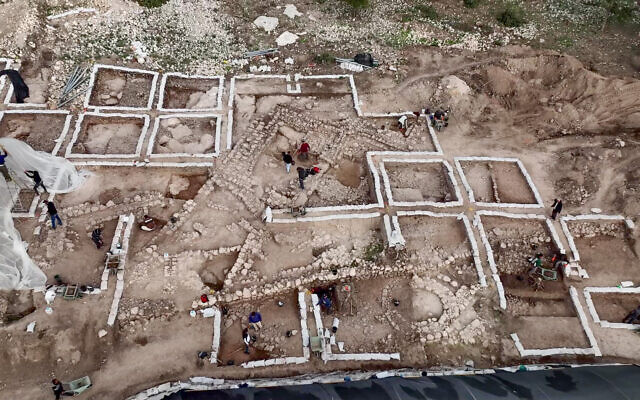Archaeologists have unearthed a large settlement on the outskirts of Beit Shemesh dating from the early Bronze Age some 5,000 years ago, providing “a view of the beginning of the urbanization process in the Land of Israel,” the Israel Antiquities Authority said Tuesday.
Exactly who inhabited the site is unknown, but it may have been inhabited by the ancestors of the biblical Canaanites, said archaeologist Ariel Shatil, a graduate student at the University of Haifa and one of the directors of the dig, speaking to The Times of Israel by phone.
“It’s a very ancient period, and they didn’t leave much” in the way of written materials, Shatil said, adding that it’s possible that these were “among the people who developed into what we know as Canaanites, but we really don’t know.”
The Canaanites, portrayed in the Hebrew Bible as local antagonists of the Israelites as they were conquering the Land of Israel, are usually considered by archaeologists and historians to have been a civilization and culture that coalesced around 2,000 BCE, about a millennium after the recently excavated settlement.
The site, dubbed Hurvat Husham, “is exceptional not only because of its size, but because it reveals to us some of the first characteristics of the transition from village life to urban life,” the archaeologists said.
The findings at the site include a large public building, likely a “cultic worship site,” which contained a room with a unique collection of intact clay vessels, the IAA said.
Adjacent to and surrounding this building, the archaeologists found rows of large standing stones, which were set in place “even before this enclosed public building was erected,” the researchers said.
“It seems that originally there was an open cultic activity area for the general public, which then transformed into ritual activity in an enclosed compound with more controlled access,” said Dr. Yitzhak Paz, Early Bronze Age expert at the IAA.
“This development process on the site, along with other processes, attests to an increase in social complexity,” an indicator of “urbanization development in Israel during the Early Bronze Age,” Paz added.
This period is “one of the most complex in Israel’s history,” the researchers said, a time of dramatic changes as population and social complexity were rapidly increasing — phenomena linked to increased urbanization and the development of more hierarchical power structures.
Just a few generations later, there were already large walled cities in the area with palaces, public buildings and more developed economies, including at Tel Yarmouth, a site also located near modern Beit Shemesh.
Hurvat Husham was clearly “on the way to becoming a city… we believe that [the population was] a little more than a thousand at best,” Shatil said.
The temple building is important because “we know of almost no public buildings in Israel from this ancient period,” indicating that “this is probably one of the earliest temples ever discovered in the Judean Lowlands,” Shatil said.
The building, because “the size of this structure that we uncovered, its broad walls, the benches inside it and other variables indicate that it is an important and exceptional structure with a public function – perhaps a temple,” the IAA said.
The possible temple building contained “about 40 vessels preserved intact. Among them were also many tiny vessels, whose size suggests they were not for domestic use, but rather had a mainly symbolic purpose,” the IAA said.
These “miniatures are very small and not very functional for everyday use such as cooking or storage,” Shatil said. The ceramic vessels were left in “this specific room. It seems someone collected these vessels, arranged them nicely, and then left. We don’t know why… It’s very unusual,” he added.
The room showed signs of burning and some of the vessels had fallen on top of each other, the press release noted. Additional examinations will be able to tell if these vessels held regular materials such as oil or wheat, or more exotic substances used during rituals at the site.
In Hurvat Husham, archaeologists also uncovered several kilns, among the earliest discovered in Israel, several large stone granaries, and areas with houses where the inhabitants lived.
The larger circular granaries, which were “concentrated next to the temple,” indicated that “there was someone who takes resources from the people, who manages and distributes. That’s a phenomenon of social development, there is someone who was managing things… it’s something we did not expect to find,” Shatil said.
The archaeologists discovered three ancient kilns used to fire pottery, but those were distributed around the settlement, each next to a house, indicating that making pottery was practiced by individuals and was not a centralized industry, Shatil said.
Hurvat Husham was discovered in 2021 during explorations undertaken in advance of an expansion of industrial and business areas in western Beit Shemesh, and the IAA is scheduled to continue excavations at the site.
The rare collection of intact pottery vessels discovered in the temple building is to be displayed to the public this week in Jerusalem, as part of the annual “Discoveries in the Archaeology of Jerusalem and its Surroundings Conference,” to be held on Wednesday and Thursday at the IAA’s Schottenstein National Campus for the Archaeology of Israel.

No comments:
Post a Comment